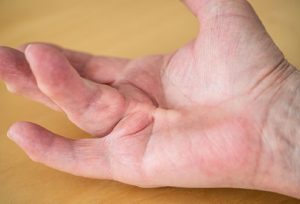Dupuytren’s

Dupuytren’s is an abnormal thickening and tightening of the normally elastic tissue beneath the skin of the palm and fingers. This tissue is called fascia. The fascia contains strands of fibers, like cords, that run from the palm upward into the fingers. In Dupuytren’s, these cords tighten, or contract, causing the fingers to curl forward. In severe cases, it can lead to crippling hand deformities.
SYMPTOMS:
- The first symptom for many patients is one or more lumps or nodules under the skin in the palm of the hand.
- The lump may feel tender and sore at first, but this discomfort eventually goes away.
- The nodules cause tough bands of tissue to form under the skin in the palm. These inflexible bands cause the fingers to bend, or “curl,” forward toward the wrist.
- As this curling gets worse, it becomes difficult, if not impossible, to straighten the fingers.
- The pinkie and ring fingers are most often affected, appearing clenched. Both hands are usually involved, although one may have worse symptoms than the other.
TREATMENT:
There is limited conservative treatment for Dupuytren’s Disease. There is some evidence to suggest that overnight splinting of the fingers in a straightened position could slow the progression of the disease. There is also emerging evidence in the area of radiotherapy, which can specifically target the palmar fascia to stop the growth of the tissue, similar to cancer treatments. Typically however, treatment consists of surgical intervention to remove or break down the diseased tissue.
THERAPY AFTER SURGERY:
- Regaining full hand function
- Swelling control
- Remodeling of scar tissue
- Exercises
- Splinting
We're here to help!
Geelong, Vic 3220
Appointments:
Geelong
Mon to Fri: 8:30am to 5pm
Torquay
Mon: 8:30am - 4pm
Thurs: 8am - 4pm
